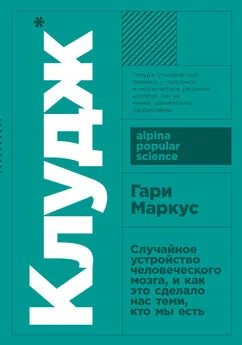Гари Маркус - Несовершенный человек. Случайность эволюции мозга и ее последствия.
- Название:Несовершенный человек. Случайность эволюции мозга и ее последствия.
- Автор:
- Жанр:
- Издательство:Альпина нон-фикшн
- Год:2011
- Город:Москва
- ISBN:978-5-91671-085-4
- Рейтинг:
- Избранное:Добавить в избранное
-
Отзывы:
-
Ваша оценка:
Гари Маркус - Несовершенный человек. Случайность эволюции мозга и ее последствия. краткое содержание
Человек привык считать себя венцом творения: свои сильные стороны – нормой, а слабости – отклонением. Подход автора принципиально другой: мы изначально несовершенны; наш мозг, как и тело, в ходе эволюции формировался достаточно случайно, из «подручных материалов» природы и являет собой так называемый клудж – нелепое, неуклюжее, но удивительно эффективное решение проблемы. Понятие клуджа проливает свет на важные стороны нашей жизни и объясняет множество проблем, с которыми мы сталкиваемся. Выводы автора оптимистичны: имея должное понимание соотношения сил и слабостей человеческого ума, мы получаем возможность помочь не только себе, но и обществу.
Несовершенный человек. Случайность эволюции мозга и ее последствия. - читать онлайн бесплатно ознакомительный отрывок
Интервал:
Закладка:
Dawkins, R.(1976). The selfish gene. New York: Oxford University Press.
Dawkins, R.(1982). The extended phenotype: The gene as the unit of selection. Oxford, UK, and San Francisco, CA: W.H. Freeman.
Dawkins, R.(1996). Climbing Mount Improbable. New York: Norton.
Debiec, J., Doyere, V., Nader, K., & Ledoux, J.E.(2006). Directly reactivated, but not indirectly reactivated, memories undergo reconsolidation in the amygdala. Proceedings of the National Academy of Science USA , 103(9), 3428-33.
Demonet, J.F., Thierry, G., & Cardebat, D.(2005). Renewal of the neurophysiology of language: Functional neuroimaging. Physiological Reviews, 85(1), 49-95.
Dennett, D.C.(1995). Darwins dangerous idea: Evolution and the meanings of life. New York: Simon & Schuster.
Dijksterhuis, A., & Nordgren, L.F.(2006). A theory of unconscious thought. Perspectives on Psychological Science, 1(2), 95-109.
Dijksterhuis, A., & van Knippenberg, A.(1998). The relation between perception and behavior, or how to win a game of trivial pursuit. Journal of Personality and Social Psychology , 74(A), 865-77.
Dion, К.K.(1972). Physical attractiveness and evaluation of children's transgressions. Journal of Personality and Social Psychology, 24(2), 207-13.
Ditto, P.H., Pizarro, D.A., Epstein, E.В., Jacobson, J.A., & MacDonald, T.К.(2006). Visceral influences on risk-taking behavior. Journal of Behavioral Decision Making , 19(2), 99-113.
Dunning, D., Meyerowitz, J.A., & Holzberg, A.D.(1989). Ambiguity and self-evaluation: The role of idiosyncratic trait definitions in self-serving assessments of ability. Journal of Personality and Social Psychology , 57(6), 1082-90.
Easterlin, R.A.(1995). Will raising the incomes of all increase the happiness of all? Journal of Economic Behavior and Organization, 27(1), 35-47.
Epley, N., & Gilovich, T.(2006). The anchoring-and-adjustment heuris-tic: Why the adjustments are insufficient. Psychological Science, 17(4), 311-18.
Epley, N., Keysar, В., Van Boven, L., & Gilovich, T.(2004). Perspective taking as egocentric anchoring and adjustment. Journal of Personality and Social Psychology, 87(3), 327-39.
Epstein, S.(1994). Integration of the cognitive and the psychodynamic unconscious. American Psychologist, 49(8), 709-24.
Epstein, S., Lipson, A., Holstein, C., & Huh, E.(1992). Irrational reactions to negative outcomes: Evidence for two conceptual systems. Journal of Personality and Social Psychology, 62(2), 328-39.
Etcoff, N.L.(1999). Survival of the prettiest: The science of beauty. New York: Doubleday.
Fazio, R.H.(1986). How do attitudes guide behavior? In R.M. Sorrentino & E.T. Higgins(Eds.), Handbook of motivation and cognition: Foundations of social behavior (pp. 1, 204-33). New York: Guilford Press.
Fedde, M.R., Orr, J.A., Shams, H, & Scheid, P.(1989). Cardiopulmonary function in exercising bar-headed geese during normoxia and hypoxia. Respiratory Physiology and Neurobiology, 77(2), 239-52.
Ferreira, R, Bailey, K.G.D., & Ferraro, V.(2002). Good-enough representations in language comprehension. Current Directions in Psychological Science, 11(1), 11-15.
Ferreira, M.В., Garcia-Marques, L., Sherman, S.J., & Sherman, J.W.(2006). Automatic and controlled components of judgment and decision making. Journal of Personality and Social Psychology, 91 (5), 797-813.
Festinger, L., & Carlsmith, J.M.(1959). Cognitive consequences of forced compliance. Journal of Abnormal Psychology, 58(2), 203-10.
Finlay, B.L., & Darlington, R.B.(1995). Linked regularities in the development and evolution of mammalian brains. Science, 268(5217), 157884.
Fishbach, A., Shah, J. Y, & Kruglanski, A.W.(2004). Emotional transfer in goal systems. Journal of Experimental Social Psychology, 40, 723-38.
Fitch, W.T.(2005). The evolution of music in comparative perspective. Annals of the New York Academy of Sciences, 1060(1), 29-49.
Fogg, В.I., Soohoo, C, Danielson, D., Marable, L., Stanford, J., & Tauber, E.(2002). How do people evaluate a web site's credibility? Results from a large study. From:
http://www.consumerwebwatch.org/news/report3_credibilityresearch/stanfordPTL.pdf.
Forer, B.R.(1949). The fallacy of personal validation: A classroom demonstration of gullibility. Journal of Abnormal and Social Psychology, 44, 118-23.
Forster, J., & Strack, F.(1998). Motor actions in retrieval of valenced information: II. Boundary conditions for motor congruence effects. Perceptual and Motor Skills, 86(3, Pt. 2), 1423-6.
Frank, R.H.(2001). Luxury fever: Why money fails to satisfy in an era of excess. New York: Simon & Schuster.
Gailliot, M.Т., Baumeister, R.R, DeWall, C.N., Maner, J.K., Plant, E.A., Tice, D.M., Brewer, L.E., & Schmeichel, B.J.(2007). Self-control relies on glucose as a limited energy source: Willpower is more than a metaphor. Journal of Personality and Social Psychology , 92(2), 325-336.
Galinsky, A.D., & Moskowitz, G.B.(2000). Counterfactuals as behavioral primes: Priming the simulation heuristic and consideration of alternatives. Journal of Experimental Social Psychology, 36(4), 384-409.
Galvan, A., Hare, T.A., Parra, С.E., Penn, J., Voss, H., Glover, G., & Casey, B.J.(2006). Earlier development of the accumbens relative to orbito-frontal cortex might underlie risk-taking behavior in adolescents. Journal of Neuroscience, 26(25), 6885-92.
Gebhart, A.L., Petersen, S.E., & Thach, W.T.(2002). Role of the posterolateral cerebellum in language. Annals of the New York Academy of Science, 978, 318-33.
Gelman, S.A., & Bloom, P.(2007). Developmental changes in the understanding of generics. Cognition, 105(1), 166-83.
Gilbert, D.T., Krull, D.S., & Malone, P.S.(1990). Journal of Personality and Social Psychology, 59(4), 601-13.
Gilbert, D.T., Tafarodi, R.W, & Malone, P.S.(1993). You can't not believe everything you read. Journal of Personality and Social Psychology, 65(2), 221-33.
Godden, D.R., & Baddeley, A.D.(1975). Context-dependent memory in two natural environments: On land and underwater. British Journal of Psychology, 66(3), 325-31.
Goel, V.(2003). Evidence for dual neural pathways for syllogistic reasoning. Psychologia, 32, 301-9.
Goel, V., & Dolan, R.J.(2003). Explaining modulation of reasoning by belief. Cognition, 87(1), B11-22.
Goldner, E.M., Hsu, L., Waraich, P., & Somers, J.M.(2002). Prevalence and incidence studies of schizophrenic disorders: A systematic review of the literature. Canadian Journal of Psychiatry, 47(9), 833-43.
Goldstein, L., Pouplier, M., Chen, L., Saltzman, E., & Byrd, D.(2007). Dynamic action units slip in speech production errors. Cognition, 103(3), 396-412.
Gollwitzer, P.M., & Sheeran, P.(2006). Implementation intentions and goal achievement: A meta-analysis of effects and processes. Advances in Experimental Social Psychology , 38, 69-119.
Graham, L., & Metaxas, P.T.(2003). "Of course it's true: I saw it on the Internet!" Critical thinking in the Internet era. Communications of the ACM, 46(5), 70-75.
Greene, J.D., Nystrom, L.E., Engell, A.D., Darley, J.M., & Cohen, J.D.(2004). The neural bases of cognitive conflict and control in moral judgment. Neuron, 44(2), 389-400.
Greene, J.D., Sommerville, R.В., Nystrom, L.E., Darley, J.M., & Cohen, J.D.(2001). An fMRI investigation of emotional engagement in moral judgment. Science, 293(5537), 2105-2108.
Greenwald, A.G., McGhee, D.E., & Schwartz, J.L.K.(1998). Measuring individual differences in implicit cognition: The implicit association test. Journal of Personality and Social Psychology, 74(6), 1464-80.
Gregory, T.R.(2005). The evolution of the genome. Burlington, MA: Elsevier Academic.
Groopman, J.E.(2007). How doctors think. Boston: Houghton Mifflin.
Haidt, J.(2001). The emotional dog and its rational tail: Asocial intuitionist approach to moral judgment. Psychological Review, 108(4), 814-34.
Haselton, M.G., & Buss, D.M.(2000). Error management theory: A new perspective on biases in cross-sex mind reading. Journal of Personality and Social Psychology, 78(1), 81-91.
Hauser, M.D., Chomsky, N., & Fitch, W.T.(2002). The faculty of language: What is it, who has it, and how did it evolve? Science, 298(5598), 1569-1579.
Herrnstein, R.J., & Prelec, D.(1992). In G. Loewenstein & J. Elster(Eds.), A theory of addiction: Choice over time (pp. 331-360). New York: Russell Sage.
Higgins, E.T.(2000). Making a good decision: Value from fit. American Psychologist, 55(11), 1217-1230.
Higgins, E.T., Rholes, W.S., & Jones, C.R.(1977). Category accessibility and impression formation. Journal of Experimental Social Psychology, 13(2), 141-154.
Hoch, S.J.(1985). Counterfactual reasoning and accuracy in predicting personal events. Journal of Experimental Psychology: Learning, Memory, and Cognition , 11(4), 719-731.
Hornstein, H.A., Lakind, E., Frankel, G., & Manne, S.(1975). Effects of knowledge about remote social events on prosocial behavior, social conception, and mood. Journal of Personality and Social Psychology, 32(6), 1038-1046.
Howard, S.(2004, November 14). Dreaming of sex costs the nation £7.8bn a year. Sunday Times (London).
Jacob, F.(1977). Evolution and tinkering. Science, 196, 1161-66.
Jacoby, L.L., Kelley, C, Brown, J., & Jasechko, J.(1989). Becoming famous overnight: Limits on the ability to avoid unconscious influences of the past. Journal of Personality and Social Psychology, 56(3), 326-38.
Jones-Lee, M., & Loomes, G.(2001). Private values and public policy. In E.U. Weber, J. Baron, & G. Loomes(Eds.), Conflict and tradeoffs in decision making (pp. 205-30). Cambridge, UK: Cambridge University Press.
Jost, J.T., & Hunyady, O.(2003). The psychology of system justification and the palliative function of ideology. European Review of Social Psychology, 13(1), 111-53.
Kagel, J.H., Green, L., 8; Caraco, T.(1986). When foragers discount the future: Constraint or adaptation? Animal Behaviour, 34(1), 271-83.
Kahneman, D., Krueger, А.В., Schkade, D.A., Schwarz, N., & Stone, A.A.(2004). A survey method for characterizing daily life experience: The day reconstruction method. Science, 306(5702), 1776-80.
Читать дальшеИнтервал:
Закладка:









